Ferrets are scientifically called Mustela furo and are part of the Mustelidae family. They are often mistaken for other mustelids because of their long, slender bodies that have an average length of 20 inches.
Ferrets can have black, white, or brown fur. Some species have mixed color patterns. These carnivorous animals enjoy a good 14-hour sleep daily and become active at dawn and dusk. They are social creatures that like spending time in groups.
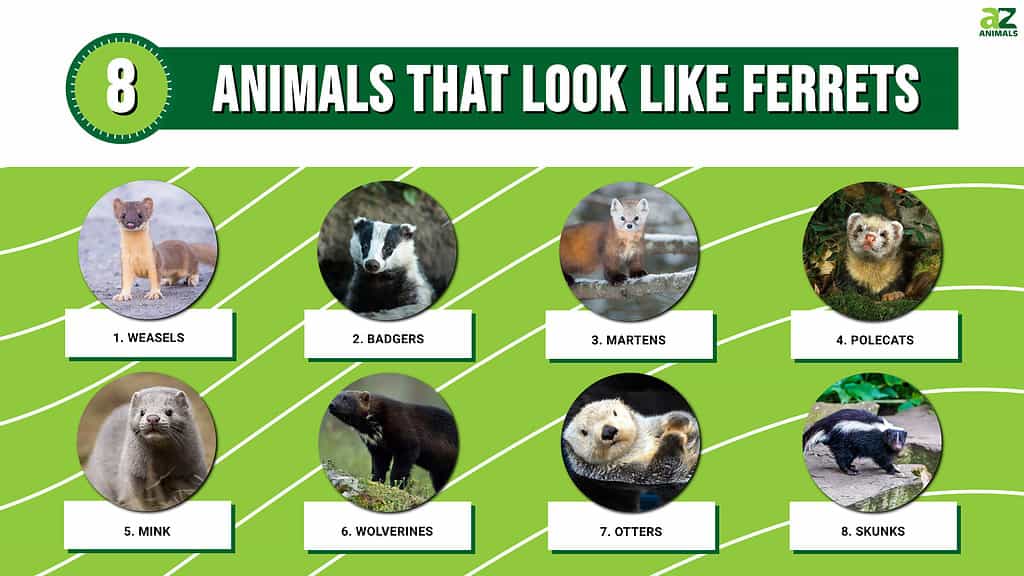
What animals resemble ferrets? Let’s find out!
1. Weasels

Weasels have white bellies and red or brown upper coats.
©Stephan Morris/Shutterstock.com
| Weasels | |
|---|---|
| Scientific name | Mustela (genus) |
| Distribution | North and Central America, Europe, Asia |
| Behavior | Social animals exhibiting typical mustelid territorial patterns |
| Diet | Carnivores |
Like ferrets, weasels are part of the Mustela genus, along with other mammals like polecats, stoats, and European minks.
These small mammals usually have white bellies and red or brown upper coats. Their bodies are long and slender, while their tails are short, measuring up to 2 inches long. Weasels have short legs but are still great predators thanks to their body length, which allows them to follow prey into burrows.
Eighteen weasel species are widely spread throughout North and Central America, Europe, and Asia. One of the most common is the least weasel, scientifically called Mustela nivalis. Least weasels have an approximate body length of 4.5 to 10 inches, and their tail is around 0.5 to 3.4 inches long, indicating it’s even smaller than a ferret’s!
These mammals do not dig their own dens but occupy burrows of other species. They are considered social creatures, although the population density highly depends on reproductive success and food supply.
2. Badgers

Badgers have short, wide bodies, short legs, elongated heads, and small ears.
©Warren Metcalf/Shutterstock.com
| Badgers | |
|---|---|
| Scientific classification | Classified within various subfamilies and genera under the Mustelidae and Mephitidae families |
| Distribution | Major populations found in North America, Great Britain, and Ireland |
| Behavior | Some are solitary; some live in setts |
| Diet | Omnivorous |
Badgers have short, wide bodies, short legs, elongated heads, and small ears. Some species have short tails, while others have tails that can grow up to 18 – 20 inches long.
Most badgers have black faces with unique white patterns, dark legs, light underbellies, and gray bodies. They have a distinctive stripe that runs along their bodies from head to tail. On average, badgers grow up to 35 inches in length and weigh around 20 – 24 pounds.
There are 15 badger species grouped into subfamilies and genera under the Mustelidae and Mephitidae families. The most common are the European and American badgers.
These animals are widely distributed in North America, Great Britain, and Ireland. They’re common in the rest of Europe, as well as in Japan and China. Indonesia hosts the Javan ferret badger, while Malaysia hosts the Bornean ferret badger.
In their natural habitats, some badgers prefer spending time alone and changing houses, while others live in setts.
3. Martens
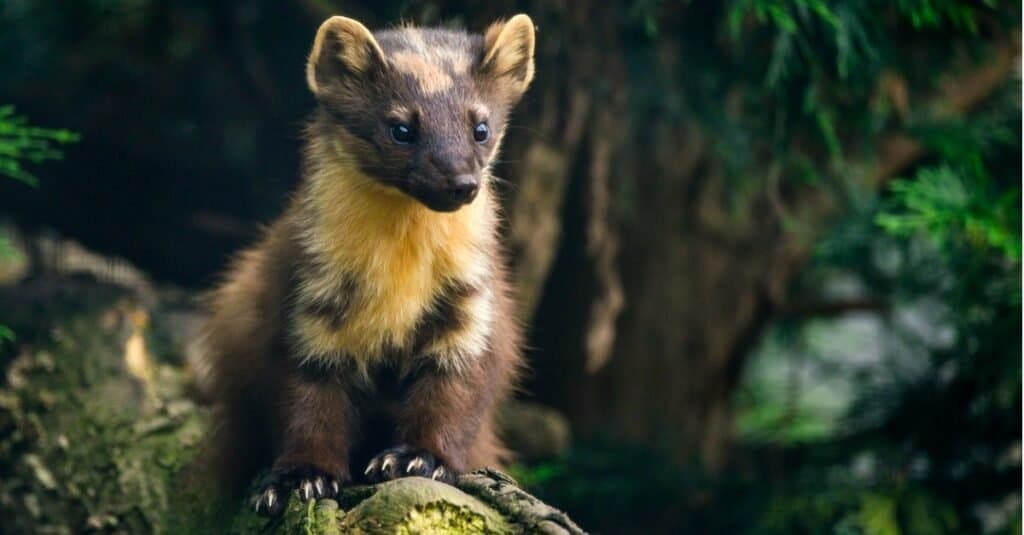
Martens are considered omnivorous animals.
©iStock.com/Matt_Gibson
| Martens | |
|---|---|
| Scientific name | Martes (genus) |
| Distribution | North America, Europe, Asia |
| Behavior | Active during the day |
| Diet | Omnivores |
Martens are part of the Martes genus, which is part of the Mustelidae family that includes ferrets. So, naturally, martens and ferrets have similar appearances. However, while ferrets have black, brown, or white fur, martens have additional yellowish shades on their fur and distinctive markings, depending on the species. American martens, for instance, have a distinctive marking on their throats and chests that is lighter than their bodies, ranging from pale straw to vivid orange.
Eight marten species are spread throughout North America, Europe, and Asia. Their behavior depends on the species and where they live. Even American martens have different behaviors that vary depending on the regions they inhabit. However, most are more active during the day. While ferrets spend most of their daily time sleeping, some American martens are active for around 10 – 16 hours a day.
Martens are considered omnivorous animals. Some sources state their favorite food is the red squirrel!
4. Polecats
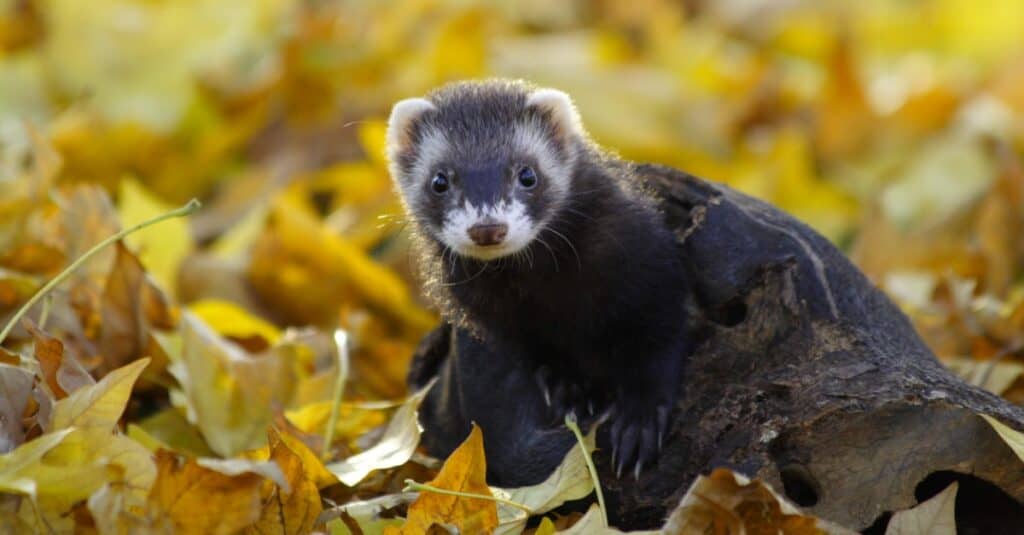
European polecats’ bodies aren’t as elongated as in other mustelid animals.
©iStock.com/marcinplaza
| Polecats | |
|---|---|
| Scientific classification | Species are spread in the Carnivora order and Ictonychinae and Mustelinae subfamilies. |
| Distribution | Africa, Europe, Asia, and North America |
| Behavior | Depends on the species |
| Diet | Carnivorous |
The term “polecat” refers to several species that are part of the Ictonychinae and Mustelinae subfamilies. Since they’re part of the Mustelidae family, they’re also mustelids like ferrets.
Here are the polecat species:
- The striped polecat
- The Saharan striped polecat
- The marbled polecat
- The steppe polecat
- The American polecat
- The European polecat
These species are found in Africa, Europe, Asia, and North America.
The European polecat is very similar to the ferret, thanks to its dark brown fur, pale underbelly, and white-brown face. However, European polecats’ bodies aren’t as elongated as in other mustelid animals. They have short legs, short tails, small eyes with dark brown irises, and long hind toes. On average, European polecat males are 13.7 – 18.1 inches long, while females are smaller, measuring around 11.4 – 15.5 inches long.
Polecat behavior highly depends on the species. While some move from one place to another, others, like European polecats, prefer a more settled way of life.
5. Mink
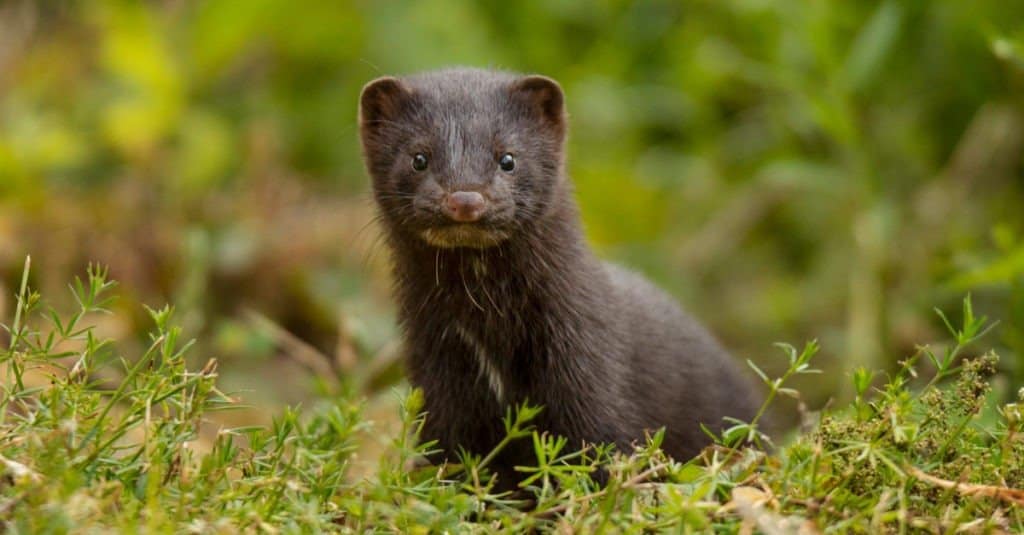
Mink are carnivorous mammals grouped into the
Neogaleand
Mustelagenera.
©An inspiration/Shutterstock.com
| Mink | |
|---|---|
| Scientific classification | Neogale and Mustela genera |
| Distribution | North America, Europe |
| Behavior | Prefer living near water |
| Diet | Carnivores |
Mink are carnivorous mammals grouped into the Neogale and Mustela genera. They are also part of the Mustelidae family, which means they closely resemble ferrets and other mustelids. However, their dark-colored, silky fur distinguishes them from their relatives. On the other hand, their size is similar to that of ferrets. Mink usually reach body lengths of around 19 – 23 inches.
These animals are partly aquatic, which means they prefer to inhabit aquatic environments. They’re often found near lakes, marshes, and riverbanks and rarely venture outside their natural habitats. Mink eat fish, small mammals, birds, and eggs. Rabbits are one of their preferred meals.
6. Wolverines
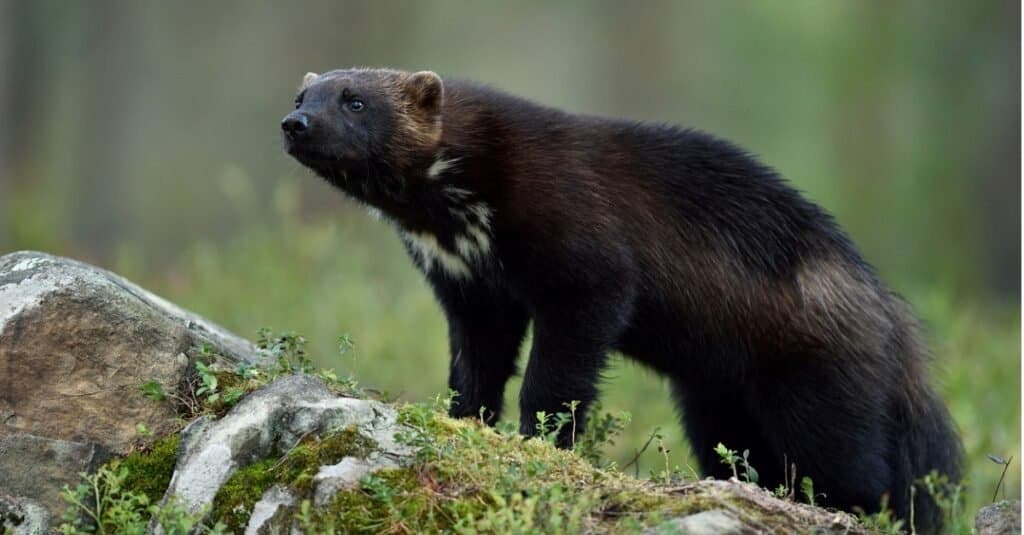
Wolverines are primarily found in subarctic and alpine tundras and the northern boreal forests.
©iStock.com/ErikMandre
| Wolverine | |
|---|---|
| Scientific classification | Gulo gulo |
| Distribution | Canada, Alaska, Siberia, Fennoscandia, European Russia, the Baltic countries, China, and Mongolia |
| Behavior | Scavengers, active hunters |
| Diet | Omnivores |
Wolverines are sometimes called carcajou, glutton, or quickhatch. They are primarily found in subarctic and alpine tundras and the northern boreal forests. They have elongated bodies, broad and rounded heads, short rounded ears, and small eyes. Their legs are short, and they have large, five-toed paws.
These mustelids have an average body length of 26 – 44 inches, a tail length of 6.5 – 10 inches, and a height at the shoulders of 14 – 18 inches. This indicates they’re much larger than ferrets. Moreover, unlike ferrets, whose fur is often a combination of black, brown, and white, wolverines have thick, dark fur.
Wolverines are ferocious predators believed to kill prey much larger than themselves. They’ve been spotted killing even adult deer!
7. Otters
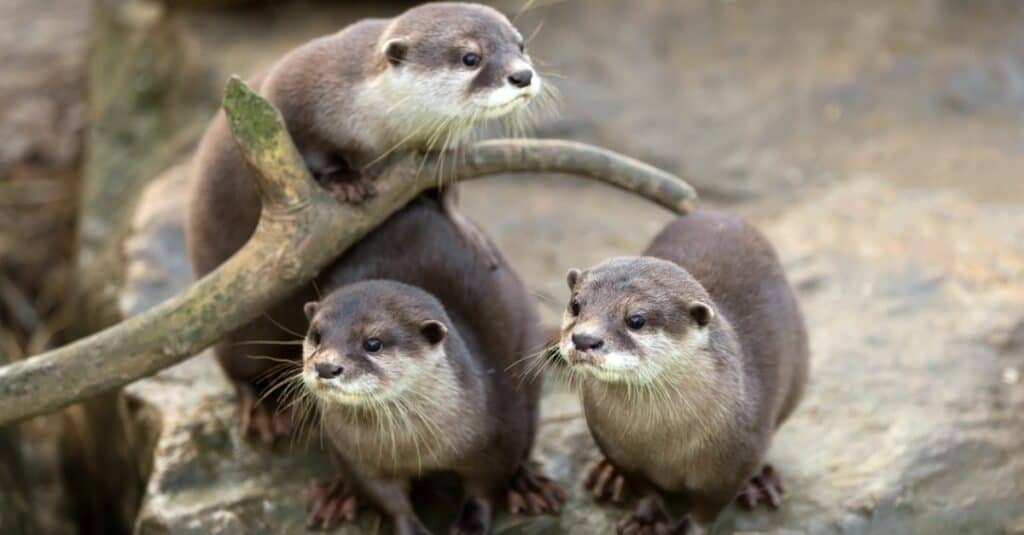
Otters primarily eat fish but sometimes feed on crabs, frogs, or crayfish.
©iStock.com/Artush
| Otters | |
|---|---|
| Scientific name | Lutrinae (subfamily) |
| Distribution | They are found on all continents except Australia and Antarctica |
| Behavior | Social and playful |
| Diet | Carnivores |
Otters are also part of the Mustelidae family and are grouped into the Lutrinae subfamily. Thirteen species of otters are further grouped into seven genera.
Depending on the species, otters can have aquatic, marine, or semi-aquatic behaviors. These animals have long, slender bodies and short limbs. Their webbed feet make them excellent swimmers! Moreover, they are great at holding their breath underwater.
Most otters are 2 – 5.9 feet long and weigh 2.2 – 99.2 pounds, making them larger than the others mentioned in our list.
Otters primarily eat fish but sometimes resort to feeding on crabs, frogs, or crayfish. They are cheerful, playful animals that can even play with stones or other things they find if no other otters are around!
Unfortunately, sources show that human activity has negatively impacted almost all otter populations. For example, only around 1,000 marine otters are left in the world, which means there are much fewer buddies to play with.
8. Skunks
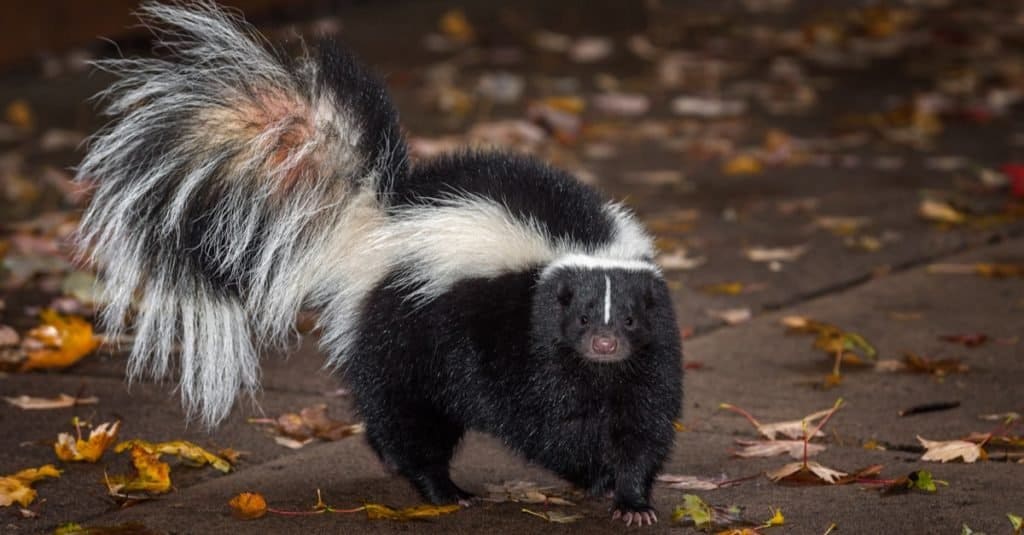
Skunks are often mistaken for ferrets due to their moderately elongated bodies.
©Geoffrey Kuchera/Shutterstock.com
| Skunks | |
|---|---|
| Scientific classification | Mephitidae (family) |
| Distribution | North and South America |
| Behavior | Crepuscular, solitary animals |
| Diet | Omnivorous |
Skunks are those black-and-white mammals that “produce” strong, unpleasant scents! Unlike other mammals in this list, skunks aren’t part of the Mustelidae family. The ten skunk species are spread between three genera in the Mephitidae family:
- The Molina’s hog-nosed skunk
- The Humboldt’s hog-nosed skunk
- The American hog-nosed skunk
- The striped hog-nosed skunk
- The hooded skunk
- The striped skunk
- The southern spotted skunk
- The western spotted skunk
- The eastern spotted skunk
- The pygmy-spotted skunk
These species are primarily distributed in North and South America, where they live solitary lives when not breeding. However, skunks will gather in communal dens if they live in colder areas.
Skunks are often mistaken for ferrets due to their moderately elongated bodies and relatively short legs, each equipped with five toes. Most species have an average length of 15.6 – 37 inches and a weight of up to 18 pounds. Some are so small that they weigh no more than one pound! Moreover, some skunk species have brown, gray, or cream-colored fur, which is another reason why many people think they’re ferrets.
Summary of 8 Animals That Look Like Ferrets
| # | Animal | Distribution |
|---|---|---|
| 1 | Weasels | North and Central America, Europe, Asia |
| 2 | Badgers | North America, Great Britain, and Ireland |
| 3 | Martens | North America, Europe, Asia |
| 4 | Polecats | Africa, Europe, Asia, and North America |
| 5 | Mink | North America, Europe |
| 6 | Wolverines | Canada, Alaska, Siberia, Fennoscandia, European Russia, the Baltic countries, China, and Mongolia |
| 7 | Otters | All continents except for Australia and Antarctica |
| 8 | Skunks | North and South America |
Would Any of the Ferret Look-Alikes Make Good Pets?

A domesticated skunk is a valid option for a pet if you’re willing to put up with the unique challenges.
©iStock.com/Edwin_Butter
When looking at these animals that look like ferrets, many of which are in the same family, do some of them qualify as pets alongside the sociable ferret?
The ones most likely to be okay as pets are minks and skunks. Minks are capable of being playful as well as affectionate if they are raised the correct way, with young ones being the best options. As they are semi-aquatic, the challenge of ownership would be in providing the right habitat for them. They are also carnivores, so feeding would be another challenge.
Skunks that have been bred in captivity can make good pets, as they have docile personalities and can show affection. Acquiring one as a suitable pet and keeping it happy would be challenging.
Polecats are solitary creatures by nature and not friendly, so they fall in the middle of the spectrum of “yes vs. no” as a pet. The same goes for martens, which some people have attempted to keep as pets, but they are dangerous due to their teeth and claws and don’t generally adapt well.
On the other end, you have badgers and wolverines, both of which are very aggressive predators. Badgers are destructive, powerful diggers, and ferocious fighters. Likewise, wolverines are also ferocious, capable of killing wolves and even bears.
Lastly, it’s against the law to own otters as pets in the U.S. and many other countries around the world. No use in speculating.
The photo featured at the top of this post is © DenisaPro/Shutterstock.com
Thank you for reading! Have some feedback for us? Contact the AZ Animals editorial team.






